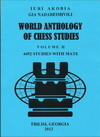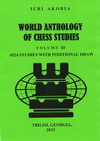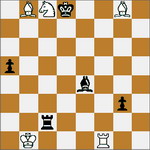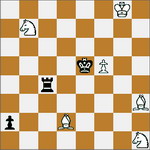PHOTOS OF STUDY COMPOSERS - part 14
In this slideshow will be periodically inserted photos of study composers (Including also photos of beginners).The shown photos are not systematized and new photos will be Added as they become available. Please, send me your photos (are accepted group pictures too).The sizes about 500x380 px
Alphabetical Index of Composer's Photos
(1-30) - (31-60) - (61-90) - (91-120) - (121-150) - (151-180) - (181)-210) - (211-240) - (241-270) - (271-300) - (301-330) - (331-360) - (361-390) - (391-420) -- (421-450) - (451-480) - (481-510)
On this page you can see these photos:
392.J.Zabinski
393.B.Laws
394.W.Shinkman
395.W.Massmann
396.B.Neuenschwander
397.J.Konikowski
398.N.Elkies
399.A.Troitzky
400.J.Kotrc
401.H.Klug & M.Zucker
402.L.Pachman
403.M.Zucker, K.Siehndel, H.Klug, F.Hoffmann
404.G.Rinder
405.R.Teichmann
407.R.Voia
408.W.Steinitz
409.E.Puig
410.G.Backcsi
411.J. Villeneuve-Esclapon
412.J.Marwitz
413.N.Ryabinin
414.Neuenschwander B
415.V.Korolkov
416. G.Nadareishvili, V.Neidze etc,
417. V.Korolkov, V.Neidze etc,
418.J.Hannelius, I.Lyapunov etc
419.G.Nadareishvili, I.Prokop
420.G.Nadareishvili, J.Hannelius etc
SOME INFORMATIONS ABOUT TBILISI
Tbilisi (Georgian: თბილისი [tb̥ ilisi] ( listen)) is the capital and the largest city of Georgia, lying on the banks of the Mt'k'vari (Kura) River. The name is derived from an early Georgian form T'pilisi (ტფილისი) and it was officially known as Tiflis until 1936.[1] The city covers an area of 726 km2 (280 sq mi) and has 1,480,000 inhabitants.
Founded in the 5th century by Vakhtang Gorgasali, the Georgian King of Iberia, and made into a capital in the 6th century, Tbilisi is a significant industrial, social, and cultural centre. The city is also emerging as an important transit route for global energy and trade projects. Located strategically at the crossroads between Europe and Asia and lying along the historic Silk Road routes, Tbilisi has often been a point of contention between various rival powers and empires. The history of the city can be seen by its architecture, where the Haussmannized Rustaveli Avenue and downtown are blended with the narrower streets of the medieval Narikala district.
The demographics of the city are diverse and historically it has been home to peoples from diverse cultures, religions and ethnicities. Despite being overwhelmingly Orthodox Christian, Tbilisi is one of the few places in the world (Sarajevo and Paramaribo being others) where a synagogue and a mosque are located next to each other, in the ancient Bath district several hundred metres from the Metekhi Church. In recent times, Tbilisi has become known for the peaceful Rose Revolution, which took place around Freedom Square and nearby locations after the contested parliamentary elections of 2003 led to the resignation of the Georgian President Eduard Shevardnadze.
Tbilisi has one international airport. Notable tourist destinations include the Holy Trinity Cathedral of Tbilisi, Freedom Square, Sioni Cathedral, Metekhi, Narikala, Rustaveli Avenue, Tbilisi Opera and Ballet Theatre, Anchiskhati Basilica, Mtatsminda Pantheon(Holy Mountain), Kashveti Church along with the National and Historic Museums of Georgia and a number of art galleries. Tbilisi is the home of famous artists. The city life was immortalized in their art by Niko Pirosmani and Lado Gudiashvili.
SOME INFORMATIONS ABOUT GEORGIA
Georgia(Georgian: საქართველო, sak’art’velo is a sovereign state in the Caucasus region of Eurasia. Located at the crossroads of Western Asia and Eastern Europe,[7] it is bounded to the west by the Black Sea, to the north by Russia, to the southwest by Turkey, to the south by Armenia, and to the southeast by Azerbaijan. Georgia covers a territory of 69,700 km² and its population is almost 4.7 million. Georgia is a unitary, semi-presidential republic, with the government elected through a representative democracy.
During the classical era independent kingdoms became established in what is now Georgia. The kingdoms of Colchis and Iberia adopted Christianity in the early 4th century. A unified Georgia reached the peak of its political and economic strength during the reign of King David IV and Queen Tamar in the 11th–12th centuries. At the beginning of the 19th century, Georgia was annexed by the Russian Empire.[8] After a brief period of independence following the Russian Revolution of 1917, Georgia was annexed by the Soviet Union in 1921, becoming the Georgian Soviet Socialist Republic. After independence in 1991, post-communist Georgia suffered from civil unrest and economic crisis for most of the 1990s. This lasted until the Rose Revolution of 2003, after which the new government introduced democratic and economic reforms.[9]
Georgia is a member of the Council of Europe and the GUAM Organization for Democracy and Economic Development. It contains two de facto independent regions, Abkhazia and South Ossetia, which gained limited international recognition after the 2008 South Ossetia war between Georgia and Russia. Georgia still considers the regions to be part of its sovereign territory.












































